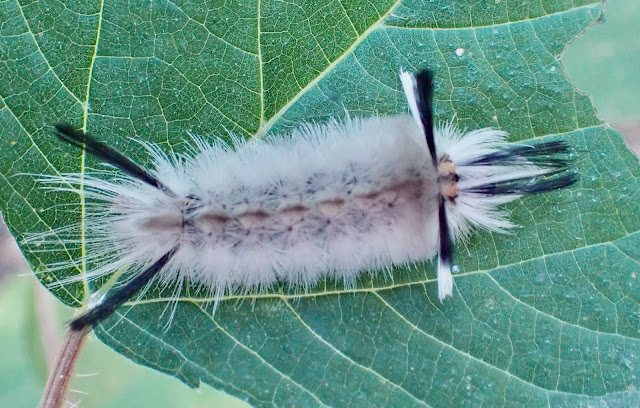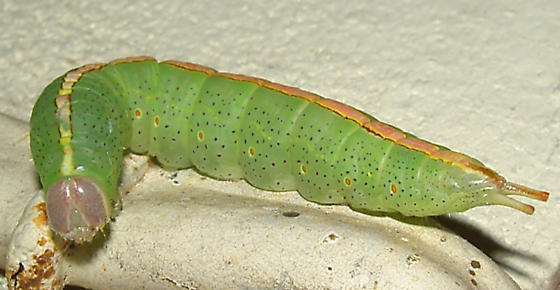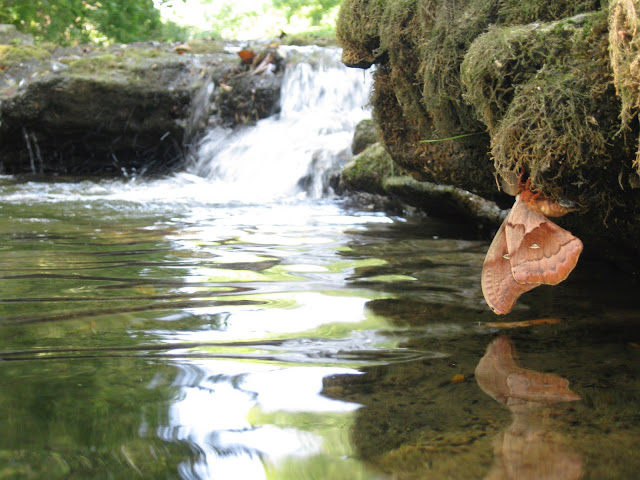
Several of these insects were found by WOLF students on Friday's field trip. This is the very common and distinctive Acanthocephala terminalis, the leaf-footed bug (LFB). The genus name comes from the Greek akanth 'thorn/spine' and kephale
'head', and refers to the spine on the front of the head. Terminalis
comes from the bright yellow-orange terminal segment of the antennae. The "leaf-foot" is obvious on the hind leg tibia.
LFBs are commonly found on shrubs in the woods or field edges. Nymphs and
adults suck sap
from various native plants, but unlike squash bugs,
they don't harm our cultivated plants. They are also found on bird
droppings which they probe with their long proboscises. This may be for
nutrition or simply a case of bad taste.

They overwinter as adults, mating in the spring and leaving clusters of eggs on leaves. I found this small cluster of insect eggs on the underside of a leaf several years ago and stored them safely in a bug box, hoping to film their births.
 |
| Egg - Click to enlarge |
I gently moved the eggs onto the sticky part of a post-it note for handling. We watched the eggs daily and noticed a change in color on day 16. They were a little cloudy and had developed some red streaks. This was a sign on maturation of the larvae.  |
Ready to hatch- note legs-T. Smith
|
The eggs are so translucent that you can actually make out the body and curled up legs in the photo by Tonya Smith.
 |
| Empty eggs - Click to enlarge. |
By the next morning the little stinkers had emerged overnight so I couldn't video the birth. Now we could see the eggs with a lid cut out by the nymph. The first instar is very distinctive with orange streaks that we had seen through the translucent eggs the day before.
I was amazed that an infant that size can emerge from a tiny egg overnight, but my wife reminded me of how compact our children were packaged before she gave birth. Once the bodies of these unfolded their size was mostly the gangly legs. There are even better photographs on Buggtracks.
 |
Newly emerged nymph
|
The upward curve of the abdomen is common to a lot of different bug nymphs such as assassin bugs. They go through 5 sequential molts. The later instars of LFB darken and develop a spiny back. As all hemiptera (true bugs) they have incomplete metamorphosis, the nymphs resembling the adults. There is a series of pictures of one molting at Bugguide. The one on the right was initially misidentified as an assassin bug nymph.
 |
Note leaf shaped tibia and long proboscis
|
Unlike beetles with their chewing mouth parts, bugs have a proboscis that resembles a hypodermic needle. Their feeding is more complex than just sucking up juices. They first inject their saliva with enzymes into the tissue, then suck up the digested liquid. Assassin bugs attack insects and other prey, while plant bugs like our LFB suck the juices of leaves and fruit. Although some leaf-footed species can be listed as agricultural pests, our LFB (
A. terminalis) is not a problem
.  |
Assassin bug
|
It can be difficult to separate some plant bugs from their assassin
bug brethren so it is best not to pick them up with bare hands if you aren't
sure.



























